Published by Joanna KOZIEŁ, Grzegorz KOMARZYNIEC, Andrzej WAC-WŁODARCZYK, Ryszard GOLEMAN, Department of Electrical Engineering and Electrotechnologies, Lublin University of Technology
Abstract. The article presents the characteristics of the net power of a wind farm as a function of wind speed, and lists the factors determining the selection of a wind farm. Classification of large wind turbine generators is illustrated. The work areas of a synchronous, 3-phase generator with permanent magnets are depicted. Responses of a given wind farm to the demand for capacitive and inductive reactive power are presented.
Streszczenie. W artykule przedstawiono charakterystykę mocy netto farmy wiatrowej w funkcji prędkości wiatru, oraz wymieniono czynniki decydujące o wyborze farmy wiatrowej. Zilustrowano klasyfikację generatorów dużych turbin wiatrowych. Zobrazowano obszary pracy generator synchronicznego, 3-fazowego z magnesami trwałymi. Przedstawiono odpowiedzi określonej farmy wiatrowej na zapotrzebowanie na moc bierną o charakterze pojemnościowym, jak i indukcyjnym. (Analiza wpływu farmy wiatrowej na jakość energii elektrycznej w sieci dystrybucyjnej).
Keywords: wind farm, farm location, permanent magnet 3-phase synchronous generator, reactive power.
Słowa kluczowe: farma wiatrowa, lokalizacja farmy, generator synchroniczny 3 fazowy z magnesami trwałymi, moc bierna.
Introduction
A specific feature of electricity is that, in terms of certain parameters, its quality is more influenced by the user than the producer or system operator. In these cases, the system user is the basic partner of the system operator in the efforts to maintain the proper quality of electricity.
It should be noted that these problems are dealt with in other standards already published or in development. The emission standards define the levels of electromagnetic disturbances which can be caused by the devices of the system users. Immunity standards set levels of disturbance that devices can tolerate without undesirable damage or loss of function. The third set of standards for electromagnetic compatibility [1],[2] levels allows the emission standards and immunity standards to be coordinated and coherent in such a way as to achieve the overarching goal of electromagnetic compatibility [3].
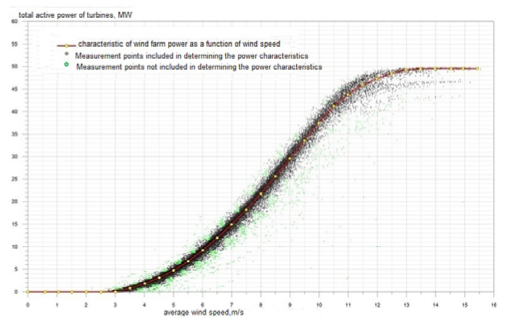
Modern wind turbines usually have a horizontal axis of rotation, and the turbine itself usually has three blades. The vast majority of turbines are equipped with asynchronous generators [4].
The wind pressure on the blades creates a pressure difference in front of and behind the blades. The turbine begins to rotate and the rotor drives a generator located in the nacelle. It is in the generator that the mechanical energy is converted into electricity. The rotational speed of a typical asynchronous generator oscillates around 1500 rpm, which requires the use of a gear located between the rotor and the generator [4].
A wind farm – also known as a wind power plant, is a group of wind turbines equipped with generators, generating electricity, powered by wind power. The energy obtained in this way is referred to as “clean” energy, because during its production the turbine does not emit pollutants related to fuel combustion.
The actual net power recorded at the transformer terminals, depending on the wind speed, is shown in Fig. 1.
Factors determining the location of the wind farm
Choosing the right location of the facility is crucial for the success of a given investment, therefore it is necessary to thoroughly analyse all factors [5]. In the case of wind farms one should:
• ensure the access of the wind farm to the National Power System,
• keep the required distances between the turbines and arrange them in such a way as to make the most efficient use of production capacity,
• exclude protected areas, areas of national parks and nature reserves,
• exclude areas adjacent to airports, railways, expressways,
• keep appropriate distances from human clusters,
• keep the statutory distances from transmission lines, e.g. high voltage and oil and gas pipelines,
• ensure compliance with applicable legal acts, including environmental guidelines.
However, the most important determinant of the location is the average wind speed for a given area during the year. It depends on the wind speed whether the wind farm will be able to produce enough energy to make the investment profitable. And so, on the basis of data collected at over 60 stations throughout the country, average wind speeds were determined for given areas [5], [6].
It should be noted that winter is the windiest period, therefore the most desirable and generating the largest amounts of energy produced by wind farms.
Wind speed is a decisive factor in the ability to produce and regulate energy in the distribution system. For an exemplary Vestas V112 turbine is use in this farm. The limiting wind speed at which the Vestas V112 turbine starts producing electricity is 3 m/s. According to the characteristics, it is the equivalent of the production of 22 kW of active power. The critical speed can also be read from the characteristics of the turbine. For this wind turbine model it is 25 m/s. Above this wind speed, the turbine will stop. As it is easy to read from the diagram, the turbine already reaches the rated power of 3.3 MW at a speed of about 13 m/s. In the event of winds blowing at speeds below 3 m/s, as recommended by both the wind farm operators and the turbine manufacturer, the turbine should be stopped. Restarting it is often problematic, e.g. in winter, when ice blocks can form on the blades. In order to prevent this, turbines are usually not stopped in such cases, but instead take power from the power grid and drive the rotor (they work by drawing power from the National Power System).
Table 1. Summary of wind speed for various time periods

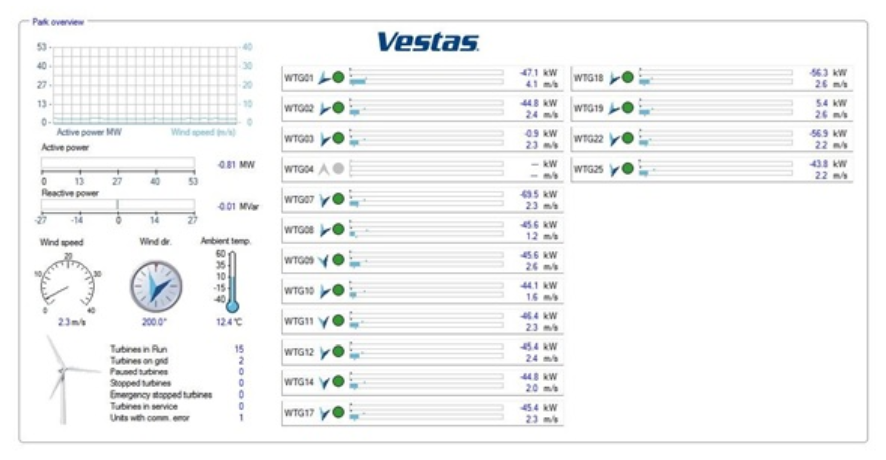
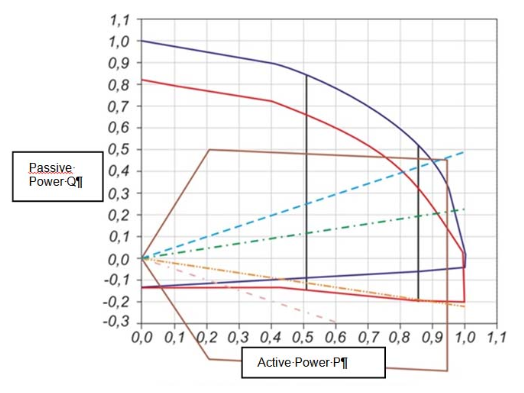
On a day when low wind speed prevails, the wind farm draws power from the grid to drive the wind turbines. The appearance of the wind farm SCADA system panel is shown in Figure 2. Despite the use of automation, it is a simpler method of control, because the start-up of wind turbines is associated with a certain risk, resulting from a power outage for the electronics in the nacelle. As can be seen, the WTG04 turbine is stopped due to some error. The farm automation has the ability to constantly interfere with the operation of wind turbines (load change, regulation change, setting angle in relation to the wind direction, starting or stopping the turbine operation). Probably due to an error or in time to repair the operation of the turbine was stopped. The remaining turbines draw their active power from the grid. For example, the WTG07 turbine draws 69.5 kW of power, and the wind speed measured at the top of its nacelle is 2.3 m/s. These are instantaneous values, refreshed by the system at regular intervals.
Each of the turbines operates at wind speeds below 3 m/s. For this reason, turbines need power from the grid to operate. It seems that only the WTG04 turbine does not draw power from the grid, but it is the turbine whose operation in the wind farm system has been suspended.
Regulation of voltage and reactive power of a wind farm in the power grid
The participation of wind turbines in the process of voltage regulation in the power grid is strictly dependent on their ability to generate reactive power. It results directly from the areas of turbine operating states. Modern wind farms are adapted not only to the production (generation) of reactive power, but also to its consumption from the grid. The common ones include wind farms with characteristics similar to a triangle, or more often to a polygon. The reactive power generation capabilities of such farms are large and reach up to 50% of the rated active power. Unfortunately, for small values of wind farm power, there is a close dependence of the generated active power on reactive power (Fig. 3) [7], [8], [9]. Nevertheless, the reactive power regulation function is very important from the point of view of the voltage stability of the system. In order to take a closer look at the above issue, the division of generators used in large wind turbines should be considered. Classification of large wind turbine generators : Large wind turbine generators,
• Induction (asynchronous) generators,
• Synchronous generators,
• Double-fed induction generators,
• Cage induction generators,
• Generators with wound rotors,
• Generators with permanent magnets,
• Generators with slip ring-powered rotors,
• Generators with brushless rotors,
• Generators with embedded magnets,
• Generators with surface-mounted magnets.
The generators most often used in wind turbines include a synchronous three-phase generator with permanent magnets. The areas of its work are presented in Figure 3.
The characteristics of a classic generator block, defined at the level of the generator busbars, are marked in red. The blue colour is the characteristic of the upper voltage of the block transformer. The black lines, in turn, limit the minimum and maximum value of the active power generated by the steam turbine.
This is due to the generation limitations of this turbine and boiler. Wind turbines are an excellent source of energy, as shown in Figure 3. The working area is wide. Wind farms can operate with a higher reactive power consumption while simultaneously having small active power generations. Unfortunately, for low values of the generated active power, this range is very limited and so, most of the time during the year, there is uncertainty as to the possibility of obtaining reactive power at all [10],[11]. Wind farm responses to the demand for capacitive and inductive reactive power are presented in Figure 4.
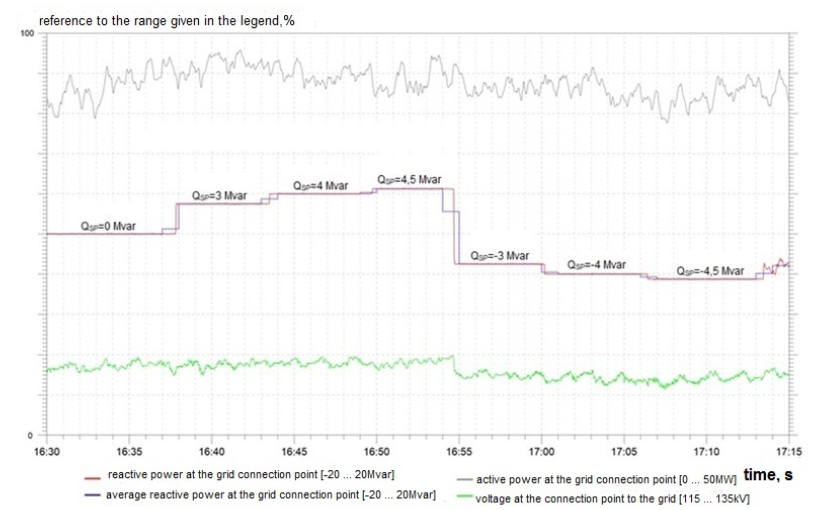
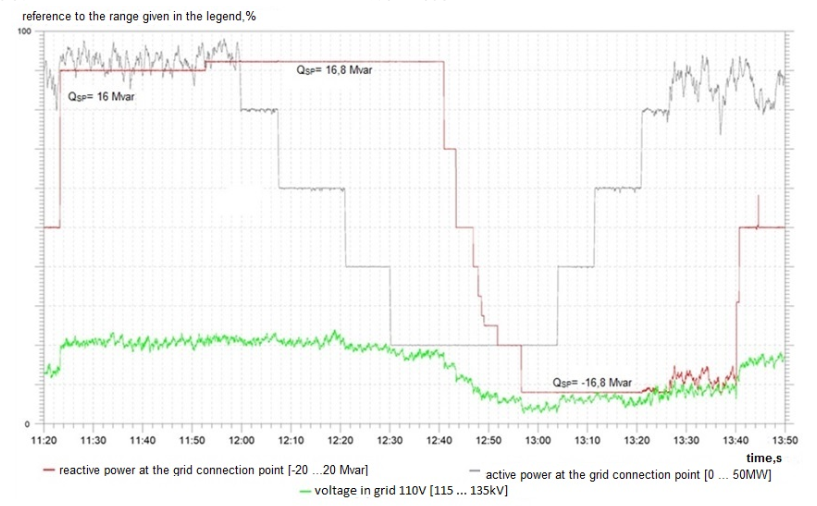
Conclusions
Wind farms have a significant impact on the regulation of voltage parameters in the power grid. The appropriate location of the wind farm has a decisive influence on the regulatory possibilities of the wind farm. The potential of wind farms has been noticed and they are undoubtedly becoming an important element supporting the regulation of the National Power System. Regulatory capacity of wind farms is not applicable to less developed energy systems, e.g. island systems. The wind farms can regulate the frequency and active power, voltage and reactive power, resulting in a constant power factor cosφ. Wind farms are able to react quickly to grid disruptions thanks to their power reserve.
REFERENCES
[1] Michałowska J., Mazurek P.A., Gad R., Chudy A., Kozieł J., Identification of the electromagnetic field strength in public spaces and during travel, 2019 Applications of Electromagnetics on Modern Engineering and Medicine PTZE 2019, pp.121-124, 8781737.
[2] Mazurek P.A., Michałowska J., Kozieł J., Gad R., Wdowiak A., The intensity of the electromagnetic field in the coverage of GSM 900, GSM 1800, DECT, UMTS, WLAN in build – up areas, 2018 Applications of Electromagnetics on Modern Engineering and Medicine PTZE 2018, pp. 159-162, 8503156.
[3] Norma EN 50160:2010
[4] Wolańczyk F,. Elektrownie wiatrowe, Wydawnictwo KaBe, Krosno 2013
[5] Dygulska A., Perlańska E., Mapa wietrzności Polski, project Czysta Energia, Słupsk, 2015
[6] Montusiewicz J., Gryniewicz-Jaworska M., Pijarski P., Looking for the optimal location for wind farms, Advances in Science and Technology Research Journal, vol. 9, s. 135-142, 2015
[7] Kacejko P., Pijarski P., Gałązka K., Prosument – krajobraz po bitwie, Rynek Energii, vol. 117, nr 2, s. 40-44, 2015
[8] Pijarski P., Wydra M., Kacejko P., Optimal control of wind power generation, Advances in Science and Technology Research Journal, vol. 12, nr 1, s. 9-18, 2018
[9] Zmarzły D., Badania jakości energii w wybranej farmie wiatrowej, Politechnika Opolska, Opole 2014
[10] Kacejko P., Pijarski P., Gałązka K., Prosument – przyjaciel, wróg czy tylko hobbysta, Rynek Energii, vol. 114, nr 5, s. 83- 89, 2014
[11] Pijarski P., Rzepecki A., Wydra M., Efektywne zarządzanie mocą farm wiatrowych, Rynek Energii, vol. 111, nr 2, s. 69-74, 2014
Authors: dr inż. Joanna Kozieł, Department of Electrical Engineering and Electrotechnologies, Faculty of Electrical Engineering and Computer Science, Lublin University of Technology, ul. Nadbystrzycka 38A, 20-618 Lublin, e-mail: j.koziel@pollub.pl; dr hab. inż. Grzegorz Komarzyniec, prof. uczelni, Department of Electrical Engineering and Electrotechnologies, Faculty of Electrical Engineering and Computer Science, Lublin University of Technology, ul. Nadbystrzycka 38A, 20-618 Lublin, e-mail: g.komarzyniec@pollub.pl; prof. dr hab. inż. Andrzej WacWłodarczyk, Department of Electrical Engineering and Electrotechnologies, Faculty of Electrical Engineering and Computer Science, Lublin University of Technology, ul. Nadbystrzycka 38A, 20-618 Lublin, e-mail: a.wacwlodarczyk@pollub.pl; dr hab. inż. Ryszard Goleman, prof. uczelni, Department of Electrical Engineering and Electrotechnologies, Faculty of Electrical Engineering and Computer Science, Lublin University of Technology, ul. Nadbystrzycka 38A, 20-618 Lublin, e-mail: r.goleman@pollub.pl.
Source & Publisher Item Identifier: PRZEGLĄD ELEKTROTECHNICZNY, ISSN 0033-2097, R. 97 NR 12/2020. doi:10.15199/48.2020.12.43